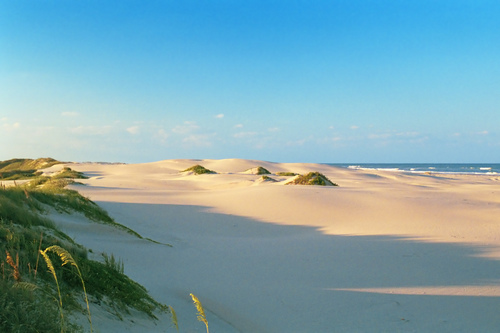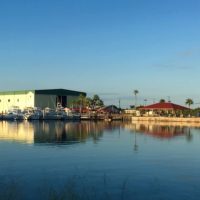by Texas Beach Vacation | Apr 20, 2010 | South Padre
Resaca de la Palma State Park — Texas’ newest state park and the eighth link in the World Birding Center chain stretching the breadth of the Rio Grande Valley — will host a grand opening celebration on Saturday, Dec. 6 in this border city.

by Texas Beach Vacation | Apr 20, 2010 | South Padre
he following are excerpts from recent Texas Parks and Wildlife Department law enforcement reports.
Rodeo in Sonora: On Nov. 30, a Sutton County Game warden received a call about two buck deer attached at the antlers by a large entanglement of wire. One of the deer was alive and the other was dead after being gored by a third buck deer. The location of the call was in the town of Sonora and several spectators were at the scene when the game warden arrived. A plan was developed and the necessary equipment, two ropes and wire cutters, were obtained. With help from a Sonora police department officer, who managed to rope the head of the deer while the game warden roped the back feet, the deer was stretched out in true rodeo head and healer fashion and the wire was cut from the bucks’ heads. The surviving buck was last seen jumping a fence and leaving town at a high rate of speed.
by Texas Beach Vacation | Apr 20, 2010 | News
Some exciting news for entomologists: a new species of tree cricket has been found in the United States. On May 16, 2009, Nancy Collins from Wisconsin and Laurel Symes, a PhD candidate at Dartmouth University, heard a tree cricket sing at Resaca de la Palma State Park and World Birding Center in Brownsville. On a return trip in June they found another cricket at Bentsen Rio Grande State Park, another World Birding Center in Mission. Further analysis by Dr. Thomas J. Walker, Professor Emeritus, University of Florida-Gainesville, revealed that it was an unnamed species of Oecanthus. Collins says that it will be called Alexander’s tree cricket, in respect of R. D. Alexander who first discovered them in Mexico in the 1960s.

by Texas Beach Vacation | Apr 20, 2010 | South Padre
The World Birding Center, a network of nine Rio Grande Valley parks and nature centers dedicated to avian conservation and education, has won national recognition from the Society of American Travel Writers for promoting eco-friendly travel.

by Texas Beach Vacation | Apr 20, 2010 | South Padre
Stick another feather in the cap of the Lower Rio Grande Valley to boost its already sizable reputation as one of the nation’s hottest birding spots.
A team of Rio Grande Valley birders at Estero Llano Grande State Park recently learned they placed first in the state and second in the United States in Birdwatcher’s Digest magazine’s Big Sit! competition held over a 24-hour period in October at locations throughout the world. It was the first time a team from the state park, which is one of the state’s nine World Birding Center sites, had competed in the Big Sit!
by Texas Beach Vacation | Apr 19, 2010 | News
He broke a six-year-old state record with a 25-yard cast on a rod he built himself. And he’s just 13.
Sugarland, Texas, eighth-grader Nick Rizopoulos topped the existing state fly fishing record for common snook with a 29-inch, 6.5 pound fish he caught in the Brownsville Ship Channel Nov. 25.
by Texas Beach Vacation | Apr 19, 2010 | Mustang Island
For the fourth year in a row, a regional partnership between the Gulf Ecological Management Sites (GEMS) Program and the National Oceanic and Atmospheric Administration (NOAA) Community-Based Restoration Program is inviting preproposals for habitat restoration projects.
The Gulf of Mexico Foundation, a nonprofit organization, manages the partnership funds and seeks projects that restore marine, estuarine and riparian habitats to benefit living marine resources and to provide educational and social benefits by significantly involving the community.
by Texas Beach Vacation | Apr 19, 2010 | Padre Island
The San Pedro Ranch owned by Texas Parks and Wildlife Commission Chairman Joseph Fitzsimons and his family has received the 2005 Outstanding Rangeland Stewardship Award from the Texas and Southwestern Cattle Raisers Assoc. and the Texas Section of the Society for Range Management.
The award was presented Oct. 6 at the TSSRM annual awards banquet at South Padre Island. This is the second year for this award, which was created “to recognize those who have demonstrated outstanding skill and knowledge in practicing sound management and care of rangeland resources.”
by Texas Beach Vacation | Apr 19, 2010 | News
Texas Parks and Wildlife Department officials believe isolated fish kills observed this week along the lower Texas coast can be attributed to red tide. “Our conclusion is that there is not a large red tide bloom along the South Texas coast,” says Dave Buzan, a scientist with TPWD Coastal Fisheries who heads the agency’s marine Kills and Spills Team. “Red tide is likely present but only in small patches and only causing intermittent relatively small fish kills. There is no evidence at this time that there will be a major bloom impacting Texas beaches. W
by Texas Beach Vacation | Apr 19, 2010 | Padre Island
A team that finished last nine years ago stormed back to win the weeklong competition in this year’s 9th Annual Great Texas Birding Classic, which has announced a list of habitat conservation projects selected by winning teams.






